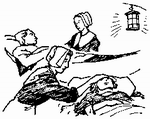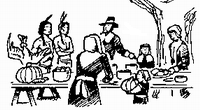Thanksgiving Day
Almost in every culture in the world there is a celebration of thanks for rich harvest. The American Thanksgiving began as a feast of thanksgiving almost four hundred years ago.
In 1620, a religious community sailed across the Atlantic Ocean to settle in New World. They settled in what is not known as the state of Massachusetts. Their first winter in America was difficult. They arrived too late to grow a rich harvest. Moreover, half the Iroquois Indians taught them also how to grow other crops and how to hunt and fish.
In the autumn of 1621 they got a beautiful harvest of corn, barley, beans and pumpkins. The colonists had much to be thankful for, so they planned a feast. The colonists learned from Indians how to cook cranberries and dishes of corn and pumpkins.
In following years many of the colonists celebrated the harvest with a feast of thanks. After the United States gained independence, Congress recommended one yearly day of thanksgiving for the whole country. Later, George Washington suggested the date November 26 as Thanksgiving Day. Then, after the civil war, Abraham Lincoln suggested the last Thursday in November to be the day of thanksgiving.
On Thanksgiving Day, family members gather at the house of an older relative, even if they live far away. All give thanks for everything good they have. Charitable organizations offer traditional meal to the homeless.
Foods, eaten at the first thanksgiving, have become traditional. The traditional thanksgiving meal consists of roast turkey stuffed with herb-flavored bread, cranberry jelly, mashed potatoes, pumpkin pie. Other dishes may vary as to region: ham, sweet, potatoes, creamed corn.
A Celebration of Thanksgiving
 The origins of Thanksgiving predated the Pilgrims at
least 2, years. After the harvest of each year was safely stored for the
winter, Celtic priests, the Druids, would mark the end of their calendar with
prayers to their sun god for protection during the period of darkness and cold
of winter. These harvest festivals evolved and became combined with a Christian
Feast of Saints.
The origins of Thanksgiving predated the Pilgrims at
least 2, years. After the harvest of each year was safely stored for the
winter, Celtic priests, the Druids, would mark the end of their calendar with
prayers to their sun god for protection during the period of darkness and cold
of winter. These harvest festivals evolved and became combined with a Christian
Feast of Saints.
The first formal celebration of Thanksgiving in North America was held by an English explorer, Martin Frobisher, who attempted to establish an English settlement on Baffin Island, after failing to discover a northern passage to the Orient in 1576. Canada established the second Monday in October as a national holiday, "a day of general thanksgiving," in 1957.
The Pilgrims of Plymouth Rock held their Thanksgiving in 1621 as a three day "thank you" celebration to the leaders of the Wampanoag Indian tribe and their families for teaching them the survival skills they needed to make it in the New World. It was their good fortune that the tradition of the Wampanoags was to treat any visitor to their homes with a share of whatever food the family had, even if supplies were low. It was also an amazing stroke of luck that one of the Wampanoag, Tisquantum or Squanto, had become close friends with a British explorer, John Weymouth, and had learned the Pilgrim's language in his travels to England with Weymouth. Wild turkey was on the menu, along with corn (Pilgrim's wheat), Indian corn, barley, peas, waterfowl, five deer (brought by the Indians as their dish to pass), bass and cod. Since then, we've added such delicacies as ham, sweet potatoes, corn on the cob, popcorn, cranberry sauce and pumpkin pie. What? Pumpkin pie is not authentic? The Pilgrims probably made pumpkin pudding sweetened with honey, but they didn't have sugar, crust or whipped topping. Life was tough back then.
The turkey tradition was
really pushed by Benjamin Franklin, who wanted to make it the United States
national symbol because it is a quick runner, wary,  with sharp eyesight, and exhibited a regal stance, at
least to Franklin. While the bald eagle nudged out the wild turkey for our
official national symbol, Norman Rockwell has probably made the image of the
family Thanksgiving turkey even more famous, and certainly more mouth watering.
with sharp eyesight, and exhibited a regal stance, at
least to Franklin. While the bald eagle nudged out the wild turkey for our
official national symbol, Norman Rockwell has probably made the image of the
family Thanksgiving turkey even more famous, and certainly more mouth watering.
The actual day we celebrate Thanksgiving in America was picked by our presidents, starting with George Washington who declared a one-time holiday. Abraham Lincoln proclaimed the last Thursday in November to be "...a day of Thanksgiving and Praise to our beneficent Father who dwelleth in the Heavens." Franklin D. Roosevelt moved it to the fourth Thursday of November in 1939, to prevent a 5 week November from shortening the Christmas shopping season.
T for time to be
together, turkey, talk, and tangy weather.
H for
harvest stored away, home, and hearth, and holiday.
A for
autumn's frosty art, and abundance in the heart.
N for
neighbours, and October, nice things, new things to remember.
K for
kitchen, kettles' croon, kith and kin expected soon.
S for
sizzles, sights, and sounds, and something special that abounds.
Did You Know?
A
Frobisher and early colonists, giving thanks for safe passage, as well as pilgrim
celebrations in the US that began the traditions of turkeys, pumpkin pies, and
the gathering of family and friends.

There are three traditions behind our Canadian Thanksgiving Day.
1.
L 2.
I 3.
T
Now, more than
ever, we're reminded to treasure our families, communities, and the institutions
that raise our spirits, help the less fortunate, and express our passions. As
we move forward, join us in a new tradition. This year, during the Thanksgiving
holiday, as you come together for family, friendship, food and fellowship,
celebrate Giving Day.
Make a Giving Day commitment
to support your favorite cause with a gift of time or
money
Express your values,
compassion, and passions with your loved ones by sharing your Giving Day
commitment at Thanksgiving dinner
Build a new tradition by
encouraging others to celebrate Giving Day Thanksgiving
Day In the fall of 1620 the Pilgrims crossed the
Atlantic Ocean on their ship, the Mayflower. The Combine
turkey, noodles, and peas in a 2-quart buttered casserole dish. Melt 2
tablespoons butter in a saucepan. Sauté onion and mushrooms; blend in
soup, milk and seasonings. Pour soup mixture over meat; top with shredded
cheese. Bake in a 350 degree F. for about 20 to 30 minutes. а
A
A
T
 The English Puritans
were trying to "purify" the Church of England, but finally they
formed their own church. They left England and went to Holland and then to
America. They became "Pilgrims" because they were travels in search
of religious freedom.
The English Puritans
were trying to "purify" the Church of England, but finally they
formed their own church. They left England and went to Holland and then to
America. They became "Pilgrims" because they were travels in search
of religious freedom.
 trip was very
difficult, and many people got sick. But while they were on the crowded ship,
the Pilgrims agreed on a form of government for their new colony. This
agreement, the Mayflower Compact, established the principles of voting and
majority rule.
trip was very
difficult, and many people got sick. But while they were on the crowded ship,
the Pilgrims agreed on a form of government for their new colony. This
agreement, the Mayflower Compact, established the principles of voting and
majority rule.
 Finally on December 22
the travels landed the Plymouth, Massachusetts. There as not enough food for
the long, cold winter, and many settlers died. Then some friendly Indians, Samoset, Chief Massasoit, and Squanto, showed to the Pilgrims how to hunt, fish, and
plant corn, beans, and other foods. Because of their help, the Plymouth
settlers had a good harvest the next fall.
Finally on December 22
the travels landed the Plymouth, Massachusetts. There as not enough food for
the long, cold winter, and many settlers died. Then some friendly Indians, Samoset, Chief Massasoit, and Squanto, showed to the Pilgrims how to hunt, fish, and
plant corn, beans, and other foods. Because of their help, the Plymouth
settlers had a good harvest the next fall.
 Governor William
Bradford declared some special day of thanksgiving. The Pilgrims and the
Indians had three-day feast of deer, wild turkey and fish. There were also
nuts, corn, beans, pumpkins wild fruits, cranberries, and other foods. The
first Thanksgiving celebration was a great success.
Governor William
Bradford declared some special day of thanksgiving. The Pilgrims and the
Indians had three-day feast of deer, wild turkey and fish. There were also
nuts, corn, beans, pumpkins wild fruits, cranberries, and other foods. The
first Thanksgiving celebration was a great success.
 President Abraham
Lincoln established Thanksgiving as an official national holiday. Now every
year on the fourth Thursday of November American families and friends gather,
have a feast, and give thanks. Some traditional Thanksgiving food are turkey,
dressing, sweet potatoes, cranberry sauce, and pumpkin pie.
President Abraham
Lincoln established Thanksgiving as an official national holiday. Now every
year on the fourth Thursday of November American families and friends gather,
have a feast, and give thanks. Some traditional Thanksgiving food are turkey,
dressing, sweet potatoes, cranberry sauce, and pumpkin pie.
Turkey Noodle Casserole
 1/4 cup chopped onion
1/4 cup chopped onion
Serves 4.

